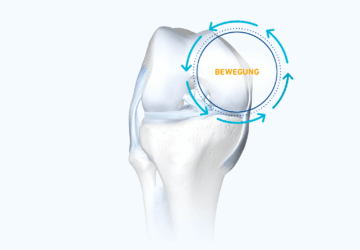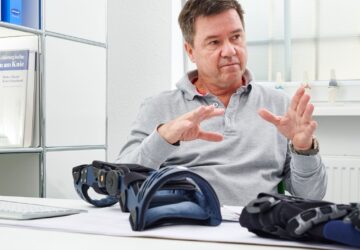In short In cases of non-specific back pain we have to actively involve patients early and detect risk factors for chronic pain as quickly as possible, “says Associate Professor Dr. med. Thilo Hotfiel. A comprehensive medical history and physical examination are the basis for an individually tailored treatment plan. To achieve a reduction in symptoms, patients need physical and muscular activation. For this goal the specialist in orthopedics and trauma surgery also prescribes lumbar supports such as the LumboTrain: “Never by themselves, however, but always as part of a multi-modal approach.
Supports·Orthosis·Back Pain
“The initial consultation is key”
Non-specific back pain: diagnosis and treatment
From Bauerfeind Life on 22.08.2025

According to Associate Professor Dr. med. Thilo Hotfiel, non-specific pain in the lower back poses a high risk of becoming chronic, unless it is treated early. That is why this orthopedist from Kirchlengern, Westphalia, attaches great importance to the initial consultation, and explains: “General practitioners and specialists need to provide guidance during the treatment process.” Important milestones include structured examination, education as well as consultation, and early patient activation.
What exactly is non-specific back pain?
PD Dr. Hotfiel: This type of back pain is referred to as such when there is no indication of specific causes, such as compression of the nerve root following intervertebral disk prolapse, an inflammatory or infectious cause, a fracture, or a painful change in the facet joints. The causes can vary and be influenced by different factors. With any kind of back pain, there are specific causes and triggers at a pathological or neurophysiological level. However, these have a secondary relevance when initially treating non-specific back pain. The initial consultation is key for how the treatment will progress: if specific causes or potentially severe conditions are suspected, we have to react quickly and organize an examination with imaging technology or laboratory tests.
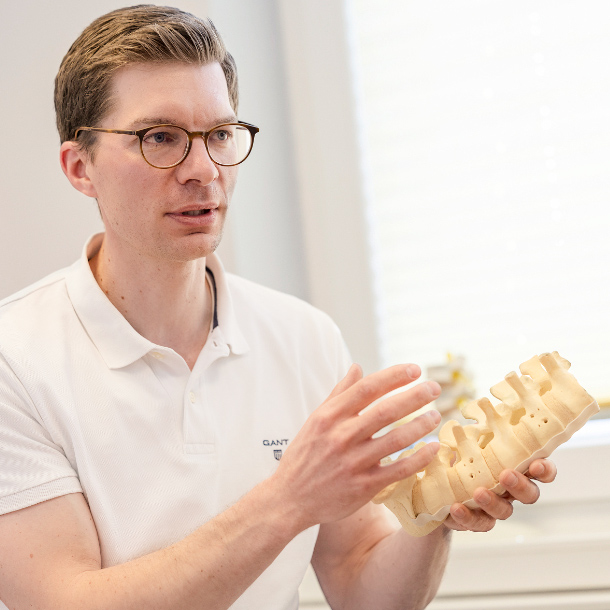
In cases of non-specific back pain, however, we have to actively involve patients early and detect risk factors for chronic pain as quickly as possible. To do this, we start with a comprehensive medical history. We ask about the location, type, and duration of the symptoms, as well as whether there was a specific trigger, and find out basic information about general symptoms, existing conditions, and what medication the patient is taking. We check on red flags, i.e. warning signs for potentially severe conditions. This includes indications of neuronic structures being involved, inflammatory processes, or possible fractures. Once these have been excluded, we move on to yellow flags, i.e. psychosocial warning signs for pain becoming chronic. General unhappiness, fatigue, or depression can increase the risk, as can the work situation – be it stress, a lack of appreciation, or repetitive movements and incorrect posture. Another very important question when taking the patient’s medical history is: are there any factors that have alleviated the symptoms?
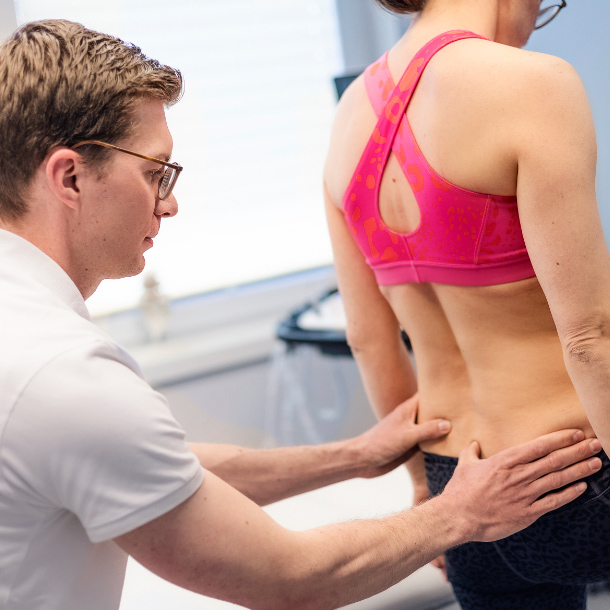
What else is part of the initial consultation?
PD Dr. Hotfiel: In addition to the medical history, a physical examination is crucial. We look at gait and posture. We conduct palpation, check movement, and perform functional as well as provocation tests. The spine or the back consist of many structures and movement segments. Each one or several interacting can trigger symptoms. Careful palpation supplies valuable information. We can often detect global or local changes in muscle tone, such as muscle or tendon-related trigger points, segment-related painful areas of irritation, or vegetative accompanying findings, e.g. local hyperemia.
“Lumbar supports like the LumboTrain provide patients with assistance and confidence.”
Associate Professor Dr. Thilo Hotfiel
This is followed by structured tests relating to movement as well as functionality, and provocation tests. A complex, multi-factor genesis usually exists, which should be included in treatment. Non-specific low back pain is one of the most common reasons patients visit general medical or orthopedic practices. We know that a third of these patients improves within three months, but two thirds still have problems even after 12 weeks. This is where pain can become chronic. Furthermore, there’s a high recurrence rate. The socioeconomic meaning is immense, and standardized as well as efficient processes have to be implemented to set the course perfectly. The NVL for low back pain (National Disease Management Guideline) can provide useful information.
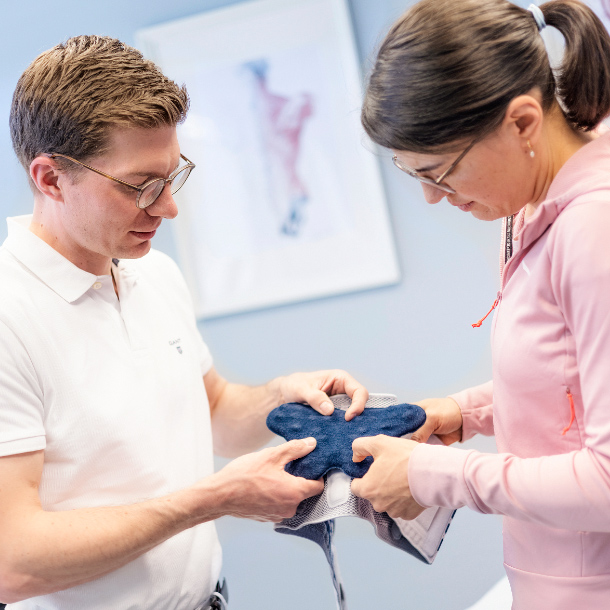
decisions. This also includes information about possible treatment options, such as an activating lumbar support.
What does the journey generally look like for patients with such symptoms?
PD Dr. Hotfiel: Many patients will initially visit their general practitioner, others will see a specialist. The most important thing is that the physician must assume a guidance or mentoring function in the treatment process straight away. They must provide patients with information and support them. The patient must be able to trust the physician. Pain shouldn’t be trivialized but too many diagnostic procedures shouldn’t be initiated either. Both can fluster a patient and make the further treatment process harder. Instead, patients should be involved in treatment decisions from the start after being given adequate information. The physician should explain the individual symptoms and, together with the patient, develop a kind of “roadmap” for the potential treatment options and the forecast timings. Furthermore, regular reevaluation should take place to find out whether treatment sufficiently alleviates the symptoms or whether diagnosis or treatment has to be intensified.
What does successful back pain treatment include in your opinion?
PD Dr. Hotfiel: Many aspects are significant and ultimately, every patient has individual options and resources.
Self-effectiveness is crucial because every patient can do a lot of good. Proactive behavior and a positive manner at a physical and psychosocial level are essential. If there are various causes in particular, improved function and reduction of symptoms is often only possible with physical and muscular activation. Cyclical, sustained movements and exercises to strengthen the muscles and to preserve mobility as well as balance should be incorporated into everyday life in the long term. These kinds of practices should be established and manifested. Patients should learn to enjoy exercise and make it a habit. It’s not just important what a patient does in two weeks or two months, but also in two or 20 years. We have to look at each patient individually, provide a good amount of support, and promote prevention as their own responsibility.
What role do knee supports and braces play in your treatment plans?
PD Dr. Hotfiel: If orthopedic aids are used, they must be linked to a specific indication and objective. When treating non-specific low back pain, I use lumbar supports, for example, as an activating and supporting option. Never by themselves, but always as part of a multi-modal approach, e.g. alongside pain therapy, physical activity, exercises patients can do by themselves, or physiotherapy, if applicable. Lumbar supports like the LumboTrain provide patients with assistance and confidence, they increase torso stability, and can help let go of postures to prevent pain as well as anxiety, whilst encouraging activity and exercise. Circular compression has various effects including influencing thermoregulation, which many patients say they find very pleasant. Nociceptive and proprioceptive effects can be enhanced by the integrated pads, for example.

As with all treatment options, the effects of supports and braces should be explained in detail to patients. If patients can’t understand the purpose of their product, compliance will decrease. The more familiar they are with their medical aids, the more regularly they’ll wear them. They can then also use them correctly. I’ll always have a follow-up appointment where I check the fit and positioning of the product, and I ask about wearing habits.
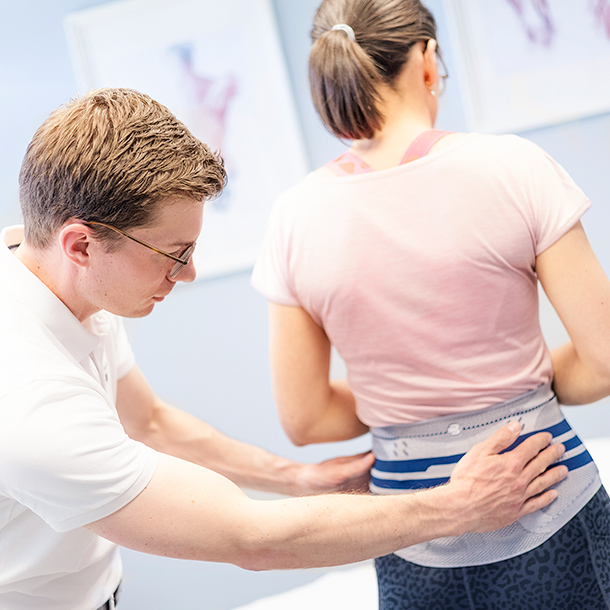
In which cases do you prefer stabilizing and relieving braces?
PD Dr. Hotfiel: This must be a case-by-case decision based on the needs as well as the functional and structural prerequisites of a patient. Stabilizing and relieving braces can be used when specific causes of symptoms have been identified at the beginning or over the course of the treatment which can be influenced orthopedically or biomechanically. Straightening or reclining braces, for example, are perfect additions to relieve the posterior sections of the spine in cases of facet joint affection. A straightening brace like the LumboLoc Forte can provide these structures with targeted relief and alleviate pain, thanks to its lordosis-reducing effect. The stabilizing effect not only encourages patients physically but also mentally to be active again and to get moving.
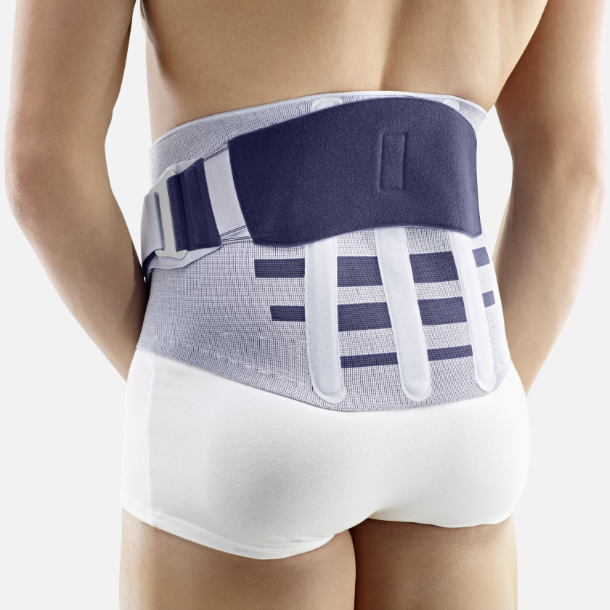
Do you have to bear something different in mind when you treat athletes?
PD Dr. Hotfiel: Of course. First of all, athletes are affected by non-specific back pain just as much as those who don’t play sports. However, there are certain patterns of injury and excessive strain that occur more in specific sports or movements. These need to be looked at in more detail. It’s important to know the type of sport and its exertion profile and to find out about the athlete’s training habits. Again, we have to look at each patient and athlete individually. We have to differentiate during the clinical examination and exclude structural injuries caused by excessive strain in particular. Considering the individual resources, we then have to implement appropriate measures and invest a lot of commitment into prevention, in addition to the actual treatment.
Pictures: Steffi Behrmann, Bauerfeind AG
Related topics
Product-Finder App

This app greatly simplifies the selection of suitable medical aids for doctors and specialist dealers. With its intuitive usability, information on Bauerfeind products is available everywhere – quickly and easily
